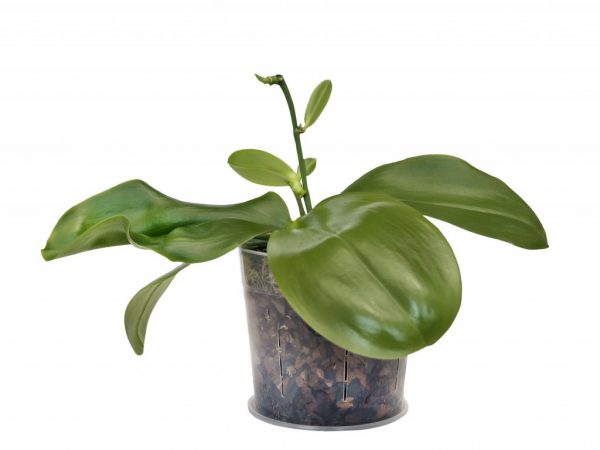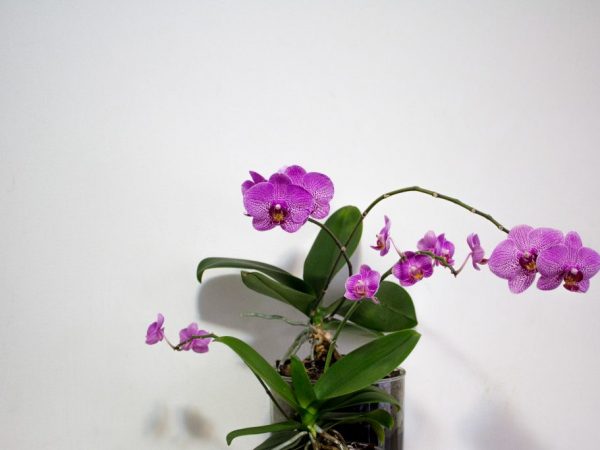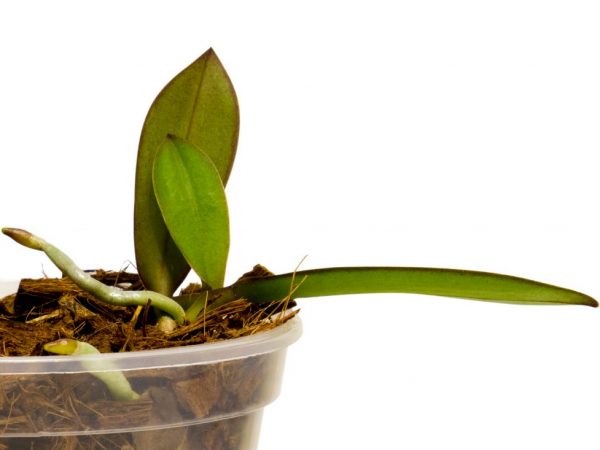What are orchid babies
Orchid babies are small shoots that appear on peduncles, at the root collar, or on stems. They grow for 5-6 months, release leaves and roots. They are then separated from the mother plant and transplanted. In this way, a new plant is obtained that retains its varietal qualities.
- How and why babies grow
- Reasons for the appearance of children
- How to stimulate the appearance of children
- Germination with cytokine paste
- Stimulation of root formation
- Stimulation with sphagnum moss
- Germination in foam
- Germination in a greenhouse
- Orchid care with babies
- Separation and transplantation of children
- Transplant of orchid babies
- Baby care

Orchid babies
How and why babies grow
Orchids often release small outgrowths from the axils of the buds that are easy to transplant. The process can be stimulated, but before that it is necessary to learn everything about orchid babies and how they appear, to master the basic rules of care.
Not all varieties are released by children, or cakes, as they are also called. Most often, this phenomenon is observed in Phalaenopsis - the most popular type of tropical flower, as well as in dendrobium. At the end of flowering, a dormant bud wakes up on the peduncle (less often - at the root collar or on the stem). A cake grows from it.
A baby in a home orchid looks like a small shoot on a trunk with 2-3 leaves, which is easy to distinguish from a new peduncle. Thin white roots extend from the base. When the cake begins to grow, the kidney swells first. Then leaves are cut from it. Roots are formed much later, sometimes they do not grow at all.
Phalaenopsis orchid babies develop unevenly, much depends on the condition of the plant, conditions and care. In some cases, the roots grow in 2-3 months, in others they delay development for six months.
The process slows down when the plant begins to bloom. If a cake appears on the stem, the root system does not develop at all. Over time, such processes wither, dry up and fall off, therefore it is better to cut them off immediately.
Reasons for the appearance of children
It is not fully understood why Phalaenopsis releases babies on a peduncle. There are 2 main reasons:
- Poor plant care. Before dying, the flower creates offspring in order to preserve the species.
- Good growing conditions. In this case, the plant has a lot of strength, the growing season is active, which provokes the appearance of shoots.
The reasons are completely opposite, therefore, the formation of a cake on an orchid cannot be stimulated with a 100% guarantee.
After flowering is complete, it is recommended to cut the peduncle 1.5-2 cm above the dormant bud. A special cytokine paste is also used.
How to stimulate the appearance of children
To get a new cake, a number of conditions are met:
- After flowering is complete, the peduncle is carefully cut off at a height of 2 cm above the sleeping bud. In this case, sterile scissors or a special sharp knife are used.
- Provide optimal lighting, expose the pot on a windowsill or balcony. Artificial lighting is arranged in winter.
- The room temperature is set at 27 ° C-30 ° C. It is with this regime that dormant buds give growth to children. If the temperature is around 24 ° C, new flower stalks will grow from the buds.
In most cases, such actions give a good result, accelerate the formation of shoots on the branches. If the phalaenopsis baby has not grown, they resort to additional stimulation.
Germination with cytokine paste
Cytokine paste is a hormonal agent for stimulating plant growth. It is sold in many flower or farm shops. With the help of the drug, it is easy to get several children of the phalaenopsis orchid on one peduncle.
Terms of use:
- The peduncle is cut at a distance of 1.5-2 cm from the dormant bud.
- With a sharp, sterile needle, a small scratch is made on the surface of the kidney. If necessary, remove dry scales.
- Apply 1.5-2 g of paste (small pea size).
- They put the pot in the light and in a warm place.
The bud awakens in 7-10 days, depending on the variety. In the same way, they stimulate the birth of new kidneys. To do this, a place is determined on the peduncle where a new bud will grow. Then they make a small scratch and smear it with a paste. After 2 weeks, the formation of a new kidney is observed, from which a cake will then appear.

The paste can only be used on healthy plants
They make sure that one peduncle does not give more than 3 processes, the buds do not grow from one point (the optimal distance between them is 5-6 cm). If the arrow has released more, it is better to carefully detach the weakest from the branch and discard. The plant is fed all this time, the condition of the soil and the temperature in the room are monitored.
Do not use the paste to resuscitate a dried plant. It is also contraindicated if the flowering vine is sluggish, sick, or attacked by pests. It is not recommended to apply it to young flowers and shoots, as well as to basal buds. If the home beauty has started up the arrows of new peduncles, it is already useless to carry out stimulation.
During the procedure, make sure that the paste does not get on the leaves, stems and roots.
Stimulation of root formation
It happens that it was possible to get a new orchid baby, but the roots do not develop on it. Some growers say that you just have to wait, stimulation does not help. Others suggest ways to help speed up root formation.
Stimulation with sphagnum moss
Stimulating the roots of orchid babies with sphagnum moss is one of the easiest and most popular ways. Step by step instructions:
- Moss for 30 min. soaked in boiled water until it begins to swell.
- A lump is formed and tied with a thread.
- Tie the moss to the base of the growing cake.
- The plant is tied to a support.
- To increase efficiency, the moss is covered with a film on top. It is removed daily to ventilate young shoots.
- Every day they spray it with water, use the Kornevin stimulant several times a week.
It is possible to achieve the appearance of roots in a couple of weeks. When they reach their normal length, the cake is separated and deposited. If the method does not work, try other methods.
Germination in foam
The technique requires ingenuity and skill. A foam structure is erected and a container of water is placed there. In this case, the process is left on the peduncle, the structure is attached to the mother flower.
The base of the cake, where the roots are expected to appear, is immersed in water. They make sure that it does not dry out, and that the process does not rot. A rooting stimulant is added to the water 1-2 times a week to force the root system to develop better. Be sure to check if the processes are rotting, if they have signs of any disease.
Germination in a greenhouse
With this method, it is recommended to separate and plant the orchid babies in a separate pot. The optimum age of the appendage is 4 months. It is cut off along with part of the peduncle. Then transferred to a shallow container with the substrate, but do not drop it too deep. Cover the top with sphagnum moss and a plastic bottle to make a small greenhouse.
Water is sprayed once a day.Make sure that no liquid gets into the center of the leaf rosette. Rooting lasts 4-6 months. All this time, they check whether the shoot has rotted. To speed up, stimulants and fertilizers are periodically applied.
When choosing a shoot for rooting, take into account that an orchid baby developing on the trunk will not take root at all, it cannot be planted. If it forms near the root collar, the process will be slowed down.
The strongest cakes grow from peduncles. But it is not always possible to root such processes. The best stimulator of development is the mother flower, which provides all the necessary substances. When disconnected, the small process often dies.
Orchid care with babies

The flower needs careful care
Phalaenopsis babies develop on the mother plant for about six months. So that they do not die, be healthy and capable of independent life, you need to properly care for the flower. It is recommended to start activities when it blooms, and continue until the processes are separated.
An adult liana is watered when the ground under it becomes dry. If the air in the room is dry, this is done 1-2 times a week. When the soil remains wet for a long time, watering is carried out every 10-12 days. From time to time, a shower is arranged for a home flower. This removes dirt and dust and prevents the appearance of pests.
The leaves are rubbed 3-4 times a week from the bottom side. It is there that most of the stomata are located, through which air enters. When they become clogged, growth slows down.
Plant feeding is carried out when flowering ends. For this kind of plants, special fertilizers are used. If they are not there, take the usual dressing for indoor flowers with a low nitrogen content, but reduce the dose by a third or a quarter.
It is not advised to use dry fertilizers in the form of sticks or tablets. They are poorly distributed over a substrate consisting of bark and moss.
At the first feeding, the dose of fertilizer for orchids is reduced by half, and for other flowers - by 3-4 times. Then it is gradually increased. Top dressing is applied after one watering. First, water is poured under the roots, they wait until it is absorbed. After about 30-40 minutes. fertilize. If the plant begins to bloom during the development of the cake, the feeding is stopped.
Separation and transplantation of children
Separation of children from the mother's orchid is carried out when 4-5 leaves and 2-4 roots are formed. The length of the roots should be about 5 cm. Such a young plant is strong, has every opportunity to grow independently. The growing season depends on the species, variety, and conditions of detention.
If the cake has formed on the peduncle, it is advised to cut it off with a sharp knife or scissors along with a branch. On both sides, 1 cm of the maternal peduncle is left.
The root baby on the hemp of the mother orchid is more difficult to separate. First, remove the top layer of the substrate and see if the root system is well formed. Then the spine is determined from which the cake grows. It is cut off, stepping back 1 cm from the base of the appendix. Carefully removed from the pot so as not to damage the young seedling. Phalaenopsis babies that have formed on the stems are simply removed. There are no roots on them and they are not able to live independently.
Transplant of orchid babies
In order for the planting of the orchid children to be successful, the soil and the container for growth are prepared in advance. The substrate is prepared from pine bark, cutting it into small pieces about 1 cm in size. Sphagnum and a little peat are added to it. Specialty soil is also sold in stores. Use a clear plastic cup or cut bottle as a pot. Drainage holes are made in the lower part.
The cut offshoot is dried in the open air for 30 minutes. Then sprinkle the roots with crushed charcoal with cinnamon, half pour the substrate into the pot. They try to plant the orchid baby there so that its root collar is at the level of the upper edge of the container.Carefully add the substrate, but do not tamp it: this will harm the roots. Cover the top with a thin layer of sphagnum moss.
It is impossible to water the flower immediately after planting - it is irrigated after 4-5 days.
Baby care
Phalaenopsis and other types of tropical flowers take a long time to develop. Planting and growing them requires patience. Throughout the year, young seedlings require greenhouse conditions.
Then, for another 1-2 years, it is recommended to care for the baby of a home orchid in the same way as for an adult plant. Only after that will it bloom.
What rules are recommended to adhere to:
- The humidity in the room where the cake is growing should be increased.
- The temperature is maintained at 27 ° C-30 ° C during the day and 18 ° C-20 ° C at night.
- To create ideal conditions, the pot is covered with a plastic or glass cover to create a mini greenhouse. From time to time, the sprout is ventilated by removing the cap for 2-3 hours, humidity and temperature are controlled.
- The cake is watered as the substrate dries.
- Once a small amount of growth stimulants and fertilizers are added to the water. Make half the dose from a special top dressing, a few drops of root or epin.
- When leaves begin to grow intensively on the seedlings, growth stimulants are canceled.
Caring for orchid babies in a small pot continues for 6-10 months. Then they are transplanted into a large container. If everything is done correctly, in 2-3 years it is easy to get an adult blooming beauty. One home flower can easily make a whole greenhouse. The main thing is to have patience and not lose interest.


